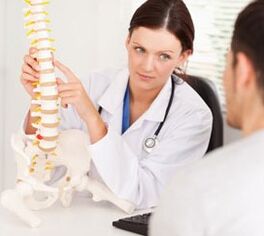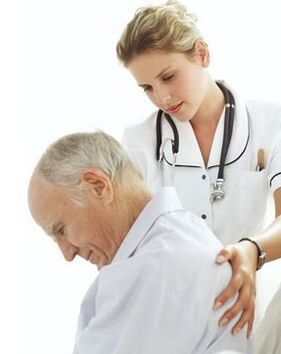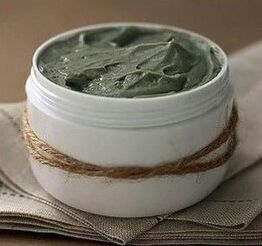Osteochondrosis-Spinal diseases, characteristic features that are degenerative-dystrophic lesions of the intervertebral disc, and then the vertebral tissue itself.
The main sign of osteochondrosis is pain in the neck or back. Among other symptoms, muscle atrophy, impaired sensitivity, disruption in internal organs is distinguished. Depending on the localization of the pathological, cervical, chest and lumbar osteochondrosis processes are distinguished. If the disease and the treatment do not pay the necessary attention, the process of damage to the spine will be irreversible.

In English literature, the term "osteochondrosis" means a group of musculoskeletal system diseases, such as osteochondropathy.
The main factor, or the cause that leads to the development of osteochondrosis, is an uneven distribution from the load on the spine, which occurs when wearing one hand or shoulder (for example, bag, backpack), staying in a sitting position in the wrong pose, resting night on an uneven mattress or pillow. Additional factors can also be an inactive lifestyle, obesity, injury and flat feet.
All of the above situations for years have led to frequent pain in the cervical, chest or sacred spine.
According to statistics, osteochondrosis occurs from 40 to 90% of the world's population, especially from the age of 30-35. Under bad conditions, the disease develops in people, most often contributes to wearing uncomfortable backpacks, especially in one shoulder, shoes and uncomfortable injuries.
The development of osteochondrosis
The development of osteochondrosis occurs in 4 selected levels (degree):
Osteochondrosis Stage 1.It is characterized by the onset of the pathological process in the nucleus polyzom of the intervertebral disc - dehydration (dehydration) occurs, and then the height of the disc decreases. At the same time, the cracks begin to appear in the fibrous ring. At this stage, patients usually do not feel any changes. Discomfort can be clear with an unusual position for a person, or an active exercise.
2 -level osteochondrosis.With the decrease in the height of the disc, the distance between the neighboring vertebrae also decreases, and the vertebrate and ligaments begin to sag slightly. This process leads to two neighboring vertebrae ultravities, which can cause slipping and/or displacement. Spondylolistz is formed. Due to the transferred vertebrae, the patient at certain loads experienced real discomfort, and sometimes illness in the field of pathology.
3 -level osteochondrosis.It is characterized by the formation of prolapesses and disc protrusions, sometimes subluxation and arthrosis occur in the intervertebral joints. Patients may feel stiff in some movements, feel tingling in the limbs, sometimes numbness. At the 3rd stage osteochondrosis, back pain, neck, and coccyx area, depending on the localization of the disease, already exists.

4 -level osteochondrosis.The body tries to correct excess vertebral movements, as well as normalize spinal function. In place of vertebral connection with pathology, bone neoplasms grow on each of them - osteophytes, which, when formed in unnecessary places, can cause microtrauma to the nerve spine, and sometimes neighboring vertebrae. In discs and joints, fibrous ankylosis process can begin. The motorcycle segment is growing and becoming a wall. At the same time, the main signs of osteochondrosis are minimized, and sometimes in general, it is practically intangible.
Symptoms of osteochondrosis
The main symptoms of osteochondrosis are discomfort and pain in the back or neck. The strength of the pain and other signs associated with the disease depends on the level of osteochondrosis.
Of course, due to the pathology of the intervertebral disc, their hernia, growth in the vertebra (osteophytes), there are a large number of disorders, such as blood circulation, nerve pinching, irritation and infringement in normal functioning. All of these disorders can cause a wide clinical picture of the disease, and are expressed in many different symptoms, so without a comprehensive diagnosis of osteochondrosis, it is very difficult to make the right diagnosis and prescribe adequate treatment.
However, we will consider the main symptoms of osteochondrosis:
- back pain, cervical region, lower back, shoulders and even ribs;
- discomfort, back stiffness with some movement, raising something;
- numbness of limbs (arms and/or feet);
- feelings of pain in the arms and legs, chills;
- muscle cramps;
- disruption in genital work;
- headache, dizziness;
- heart disease;
- impaired sensitivity;
- muscle hypotension;
- Increased fatigue, sometimes eyes.
In addition, depending on the spinal area where osteochondrosis struck, the following symptoms are distinguished:
Cervical spinal osteochondrosis.Pain in the hands and shoulders occurs, headaches, dizziness, "flies" or spots in front of the eyes, the sound of the head. These signs can also indicate the presence of vertebral artery syndrome, which can also complicate the functioning of the heart muscle and myocardial blood vessels, if other diseases are present.
Thoracic spinal osteochondrosis.Chest pain, heart area, and respiratory discomfort occur.
Lumbosacral spinal osteochondrosis.Pain in the lower back occurs, giving the foot or pelvic organs. Violations of sexual function.

The complications of osteochondrosis
If osteochondrosis is not treated and placed on the groove, this can lead to the development of the following disease and pathology:
- intervertebral disc hernia (spinal hernia);
- protrusion;
- kyphosis;
- radiculitis;
- deposits in the space between salt vertebrae;
- spinal cord stroke;
- losing weight and their atrophy;
- Legs.
The cause of osteochondrosis
- back mechanical trauma (spine);
- Physical Overvoltage of the body, hard work;
- nerve fatigue, stress;
- Violations of metabolism, poisoning;
- Stay in place with increased vibration;
- descent tendency;
- inactive lifestyle, inactive work;
- violations of posture at an early age;
- Overweight, obesity;
- flat feet;
- wear uncomfortable shoes (narrow, heels);
- Night vacations on uncomfortable beds - mattresses, pillows;
- frequent dehydration;
- low nutrition, hypovitaminosis;
- smoking;
- Pregnancy.
Osteochondrosis classification
The classification of osteochondrosis is very diverse, as the disease itself has not been fully studied.
We highlight the most popular way to separate the disease.
Osteochondrosis is distinguished. . .
By localization:
- Cervical Department ©
- The thoracic region (th or d)
- Lumbar (l)
- Sacral Department (s)
Diagnosis of osteochondrosis
Diagnosis of osteochondrosis includes the following method of examination:
- Anamnesis;
- Exam X -ray (x -ray);
- myelography;
- Neurological examination.
In addition they can appoint:
- Computed tomography (CT);
- nuclear-magnetic resonance (jamr);
- Magnetic resonance tomography (MRI).
Osteochondrosis treatment
Treatment of osteochondrosis implies the use of a set of steps to take for a long time (from 1-3 months + about 1 year for recovery), in which many patients respond very clearly. Therefore, it should be noted that, indirectly, the recommendation of the attending physician, the prediction for the patient's recovery is minimal.

Additional problems in the treatment of osteochondrosis are often self -medication. In fact, as written in the article, with this disease, the clinical picture is quite vague and broad. Patients without diagnostics begin to choose medications for what is painful, and, eliminating pain, then dealing with their daily life, while the disease continues to develop.
Treatment of osteochondrosis is performed by two main methods: conservative and surgical treatment. In addition, there are general suggestions in the treatment of osteochondrosis, such as diet, recovery.
Conservative treatment of osteochondrosis
Conservative treatment of osteochondrosis aims to stop pain syndrome, spinal normalization and its components, as well as the prevention of further dystrophic changes in a person's "axis".
Conservative treatment of osteochondrosis includes:
Drug therapy.It is used to relieve pain and inflammation of the tissue spine components, as well as the normalization of metabolic processes.
To stop the process of pain and inflammation, various therapeutic restrictions are also used. In addition, they contribute to a decrease in muscle-tonic syndrome. Among the therapeutic restrictions are: triggering point restrictions, as well as intra-repeated, paravertebral and epidural restrictions.
Physiotherapy.It is used to relieve pain, improve the effectiveness of drug therapy and during recovery. Treatment is performed using ultrasound, laser, magnetic field, low frequency current, etc.
Medical Physical Education (Training Therapy), Kinesitherapy.Specialized exercises, aimed at correcting muscle corsets, strengthening, posture correction, normalization of muscle tissue and their flexibility, nerve root decomposition, prevents the possibility of complications of the disease. All of the above things are achieved due to normalization of metabolism and intervertebral disc, blood circulation, restoring disc distance and vertebra, load distribution of the entire musculoskeletal system.
Massage.It is used to improve blood circulation, relieve stiffness and muscle tissue tension, improve general health conditions.
Hydromassage.It contributes to normalization of blood circulation, metabolism, increased muscle tone, and normalization of the nervous system. It implies a massage with the help of a flow of water with certain pressure targeted on it. True, Hydromassage has been recently used using air bubbles supplied to the body in a bath or a specially equipped pool.
Manual therapy.It is used according to the selected program, which affects the bone muscle system. It helps improve blood circulation and lymph cycle, metabolism, mobility of the musculoskeletal system, strengthens the immune system and prevents possible complications.
Advanced (attractiveness) of the spine.It is used using special equipment, to increase the intervertebral space, correction of the spinal structure, which usually leads to minimizing or relieving the pain completely.
Integrated use of the above treatment for osteochondrosis has a good effect.
Diet for osteochondrosis
With osteochondrosis, you should eat 6 times a day, in small portions, drink at least 1. 5 liters of water daily.
What can be eaten with osteochondrosis:Dairy products, low types of meat (chicken, beef), jelly, flooded fish, jellied meat, fresh vegetables (tomatoes, cucumbers, onions, carrots, beets, pepper, cabbage, celery, broccoli), fruits, avocado, nuts, sunflower seeds, sunflower seeds, sunlight seeds, sunlight seeds.
What to minimize in food for osteochondrosis:Grapes, beans (nuts, nuts, etc. -other), flour products, spicy flavors, sugar, salted foods, meat soup and smoked meat.
It is best to cook food, because with this preparation method, the product retains the maximum amount of vitamins and trace elements.

Try season salad with olive oil.
Osteochondrosis surgery treatment
Osteochondrosis surgery treatment is used if conservative methods are ineffective. Prescribed by the attending physician. It can also be used for severe spine and its components.
Treatment of osteochondrosis with folk remedies
People's recovery against osteochondrosis
Doh.Prepare a small dough from the rye flour, 300 grams, and let it lie at room temperature for a few days. Drink a glass of milk and rub the place where the back hurts with turpentine. After wrap the dough in the gauze and attach it to a sore place, tie the cellophane on top, and then a scarf or towel. After a while, you can feel burning and tingling in the area, but tolerating how much you can. Do the procedure every day. Use each group of dough no more than 3 times.
Saber.Make a tincture from Saberfish. The place where the back hurts, with the color provided with the tincture provided and fastened with a handkerchief. In addition, you can take a tincture from Saberfish a few drops before bed.
Ointment from osteochondrosis.Add 1 tbsp to the container. One tablespoon of flour, 1 egg, 100 g butter and 1 tbsp. One tablespoon of vinegar, mix everything carefully and place in a dark place for 2 days, to demand. After deleting the foam resulting from the mixture. Again, mix the mixture well and rub the ointment to the sore spot.
Radish.Mix 300 ml of carrot juice, 200 g of honey and 100 ml of vodka. Rub your back with the resulting mixture. This folk remedy also helps with radiculitis and rheumatism.



































